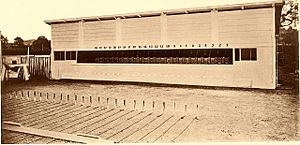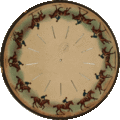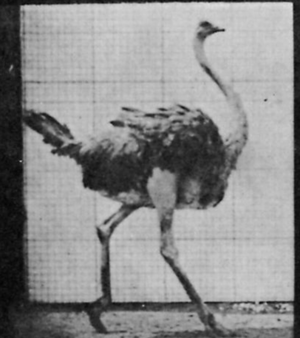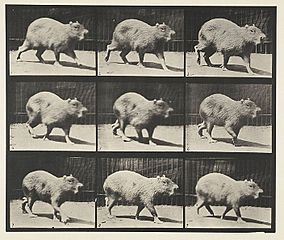Animal Locomotion facts for kids
Animal Locomotion: An Electro-photographic Investigation of Consecutive Phases of Animal Movements is a huge collection of scientific photographs. It was created by Eadweard Muybridge between 1872 and 1885. His goal was to study how animals and humans move.
Muybridge took over 100,000 pictures for this project. These photos were later put together into 781 large prints. They were published in 1887. This amazing work helped both the art of photography and the world of science.
Contents
How it Started: A Look Back
In 1879, Muybridge invented something cool called the zoöpraxiscope. This device could project images to create a moving picture. It combined ideas from photography, the magic lantern, and the zoetrope.
Muybridge would paint sequences of his motion photos onto glass discs. When these discs spun in the zoöpraxiscope, they made an early form of animation. He used these moving pictures in his lectures across the U.S. and Europe. This showed how important his work was for photography and early film.
Muybridge once said his interest in animal movement began when he saw an eagle flying. He noticed the eagle made many wing flaps at first. But then it flew a long distance with only one flap. He believed that each feather helped the bird fly. He later proved this with his photographs of eagles. These early observations in California led to his big project.
When Muybridge first worked in California, he used an older photo process. It was called the wet-plate collodion process. But when he moved to Philadelphia, he started using a newer, faster method. This dry-plate process allowed for quicker photos. The final prints were made using a special printing method called collotype.
The Big Project: Muybridge's Work
The Animal Locomotion project was a team effort. Muybridge worked with a committee at the University of Pennsylvania. In 1883, he met with William Pepper and J.B. Lippincott. They planned a scientific study of how humans and animals move. The university gave $5,000 to the project. The total cost was about $30,000. They saw it as important research for many fields. These included anthropology, medicine, and sports.
Muybridge used a special camera setup with 12 cameras. This allowed him to take many pictures in a row. He captured humans doing everyday things like walking downstairs. He also photographed athletes pole vaulting, running, and wrestling. His studies also included many animals. He even borrowed exotic animals from the Philadelphia Zoo.
Some famous animal photos include The Horse in Motion and Capybara Walking. He also photographed Ostrich Running and American Bison Cantering. For some studies, he used an even bigger setup with 24 cameras. These cameras were placed 27 inches apart along a track. Trip wires on the track would trigger the cameras to take pictures.
Between 1883 and 1886, Muybridge and his team were very busy. They created over 100,000 images of humans and animals moving. The painter Thomas Eakins even worked with Muybridge for a short time. Eakins liked to take many pictures on one photo plate. But Muybridge preferred using many cameras to capture motion.
What Was Published: The Collection
Muybridge published his study as an eleven-volume set. It was called Animal Locomotion. This set had 781 large plates. Each plate showed a series of photos of one subject moving. People could also choose 100 plates they wanted for $100.
Even though the title was Animal Locomotion, most pictures were of humans. Only about 200 images showed animals. Many of the animal photos were of horses. This was partly because Muybridge offered to photograph private owners' horses. In return, the owners would help pay for the study. The animals were usually shown running or walking. Human subjects were shown doing daily tasks or sports.
How it Changed Art: Its Impact
Many experts believe Muybridge's work changed how artists thought about movement. His photos influenced artists like Marcel Duchamp and Walt Disney. The composer Philip Glass even created an opera in 1982 called The Photographer. It included a slide show of Muybridge's motion studies. The artist Sol LeWitt was also inspired by the series of photos.
In 1992, an art gallery created an exhibit. It was called Motion and Document–Sequence and Time: Eadweard Muybridge and Contemporary American Photography. This show displayed Muybridge's animal studies next to works by 42 other artists.
Where to Find Them: Collections
The University of Pennsylvania has a large collection of Muybridge's work. It includes 740 of the 781 plates. They also have some of his old camera equipment. You can also find images from this series in many other museums. These include the Royal Academy of Arts and the Metropolitan Museum of Art.
Gallery








